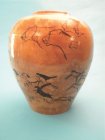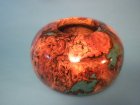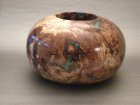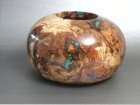john lucas
AAW Forum Expert
I have a few minutes this morning before my first client arrives so I thought I would comment on the photography I see here and try to help.
First of all. If your shooting something and having problems feel free to email me at Jlucas@tntech.edu. Send me a photo of your set up and a closer photo of the piece. I can usually make useful suggestions. There aren't any set rules for how to shoot artwork. You must be willing to move the lights and experiment.
The most common problem is shooting with the camera flash on. This produces a hot spot right in the middle of the piece and a hard shadow around the piece. I see people using the flash even if they are using Quartz halogen lamps to light the piece. I know why they do. The front of the piece is still too dark so they are trying to add light. This light is a different color than the quartz lights so it shifts the color of the piece and of course it still produces that hot spot in the middle. The solution is to move your quartz lights around until one of the lights the front of the piece.
Deer in the headlight look. I see this a lot. This is caused by using 2 lights space apart on each side. The lights are the same height and close to the same brightness. The solution is to move one light up quite high and aim it down. This produces a more natural lighting look because that's how our sun looks. Then take the second light and make it dimmer so there is a little bit of shadow on the side opposite the high light. This gives the piece more shape and changes appearance of the highlights.
Remember, you don't necessarily have to point the lights right at the subject. The edge of the light pattern produced by that light will usually be dimmer and softer looking. If you point the light toward the camera be sure and shade the lens to reduce flare from that light. If you point the light at the background you may have to shade the background to change the look of the background.
When I teach classes on shooting art work I use a photo booth made from pvc and white translucent fabric. One trick I teach is to simply move the piece around in the booth. It doesn't have to be in the center. For example lets say you put the one light up high to light the top and one side of the booth. Now the left side of the piece is too dark. Instead of adding another light which often cause other problems, just move the piece closer to the side wall on the dark side of the piece. This bounces more light back in and solves that problem.
If the front of the piece is too dark simply move the piece deeper into the booth. Quite often if this doesn't work you can put a white reflector to the shadow side of the light and bounce light back into the front of the piece. You will have to play with the position of this reflector. I have pieces of 2x8's that I cut and glued some copper grounding wire into. I can set these on the floor and tape reflectors to them so the students can position these where ever they need. I also keep smaller 2x4 pieces with several holes drilled in the front and side. We cut up smaller pieces of the ground wire and taper reflectors to these to bounce light where it's needed. Don't forget you can use aluminum foil or mirrors to bounce light if a white card isn't enough.
Color. If your camera has the option try setting the white balance to one of the other settings. Auto will often work but may change the color balance if your piece changes color. If you have tungsten or quartz lights use the tungsten white balance.
Focus Look at your photos carefully before posting. There really isn't a good reason to post an out of focus photo. You should at least reshoot a piece if it's out of focus. Auto focus doesn't always work. It will focus on the front or back of a piece or even on the background. On a bowl you should be focusing on the front or about 1/3 of the way through the piece most of the time. Occasionally if the figure on the back wall of the bowl is outstanding focus there.
Most modern cameras have focus lock. You push the shutter button down with the focus point where you want the focus. Hold the button down and shift the camera for better composition. Then finish pushing the button.
If you have trouble getting it to focus where you want try putting something in the scene such as a white piece of paper with cross hatch black lines on it. In the bowl scenario I put the paper in the bowl about a third of the way back. Push the button down and let if focus. pull the paper out and finish the shot. Granted this might take really long arms or an assistant sometimes but it does work.
Needless to say it all works better when the camera is on a tripod. Focus is easier to position. composition is better and you don't have camera movement to blur the image.
If your shooting really really glossy pieces good luck. Seriously, all the above may help but you still may have really bad reflections. If that's the case send my an e-mail and I'll send you my article on shooting really glossy pieces. It's a step by step walk through showing the problems and how I worked around them using simply lighting. It is very challenging to shoot these things and what I've included in this is a little involved. However you do get to see the trouble shooting procedures and what I steps I took to try and solve them. Below is a sample photo I did on the glossy shoot. This piece was so glossy it reflected everything in the room. As you can see I solved those problems.
Well I was going to add some more but a new photo assignment just came in and I have to hit the floor running. I also have a PDF on lighting tricks using a photo booth that might help some of you. Feel free to e-mail me for that.
First of all. If your shooting something and having problems feel free to email me at Jlucas@tntech.edu. Send me a photo of your set up and a closer photo of the piece. I can usually make useful suggestions. There aren't any set rules for how to shoot artwork. You must be willing to move the lights and experiment.
The most common problem is shooting with the camera flash on. This produces a hot spot right in the middle of the piece and a hard shadow around the piece. I see people using the flash even if they are using Quartz halogen lamps to light the piece. I know why they do. The front of the piece is still too dark so they are trying to add light. This light is a different color than the quartz lights so it shifts the color of the piece and of course it still produces that hot spot in the middle. The solution is to move your quartz lights around until one of the lights the front of the piece.
Deer in the headlight look. I see this a lot. This is caused by using 2 lights space apart on each side. The lights are the same height and close to the same brightness. The solution is to move one light up quite high and aim it down. This produces a more natural lighting look because that's how our sun looks. Then take the second light and make it dimmer so there is a little bit of shadow on the side opposite the high light. This gives the piece more shape and changes appearance of the highlights.
Remember, you don't necessarily have to point the lights right at the subject. The edge of the light pattern produced by that light will usually be dimmer and softer looking. If you point the light toward the camera be sure and shade the lens to reduce flare from that light. If you point the light at the background you may have to shade the background to change the look of the background.
When I teach classes on shooting art work I use a photo booth made from pvc and white translucent fabric. One trick I teach is to simply move the piece around in the booth. It doesn't have to be in the center. For example lets say you put the one light up high to light the top and one side of the booth. Now the left side of the piece is too dark. Instead of adding another light which often cause other problems, just move the piece closer to the side wall on the dark side of the piece. This bounces more light back in and solves that problem.
If the front of the piece is too dark simply move the piece deeper into the booth. Quite often if this doesn't work you can put a white reflector to the shadow side of the light and bounce light back into the front of the piece. You will have to play with the position of this reflector. I have pieces of 2x8's that I cut and glued some copper grounding wire into. I can set these on the floor and tape reflectors to them so the students can position these where ever they need. I also keep smaller 2x4 pieces with several holes drilled in the front and side. We cut up smaller pieces of the ground wire and taper reflectors to these to bounce light where it's needed. Don't forget you can use aluminum foil or mirrors to bounce light if a white card isn't enough.
Color. If your camera has the option try setting the white balance to one of the other settings. Auto will often work but may change the color balance if your piece changes color. If you have tungsten or quartz lights use the tungsten white balance.
Focus Look at your photos carefully before posting. There really isn't a good reason to post an out of focus photo. You should at least reshoot a piece if it's out of focus. Auto focus doesn't always work. It will focus on the front or back of a piece or even on the background. On a bowl you should be focusing on the front or about 1/3 of the way through the piece most of the time. Occasionally if the figure on the back wall of the bowl is outstanding focus there.
Most modern cameras have focus lock. You push the shutter button down with the focus point where you want the focus. Hold the button down and shift the camera for better composition. Then finish pushing the button.
If you have trouble getting it to focus where you want try putting something in the scene such as a white piece of paper with cross hatch black lines on it. In the bowl scenario I put the paper in the bowl about a third of the way back. Push the button down and let if focus. pull the paper out and finish the shot. Granted this might take really long arms or an assistant sometimes but it does work.
Needless to say it all works better when the camera is on a tripod. Focus is easier to position. composition is better and you don't have camera movement to blur the image.
If your shooting really really glossy pieces good luck. Seriously, all the above may help but you still may have really bad reflections. If that's the case send my an e-mail and I'll send you my article on shooting really glossy pieces. It's a step by step walk through showing the problems and how I worked around them using simply lighting. It is very challenging to shoot these things and what I've included in this is a little involved. However you do get to see the trouble shooting procedures and what I steps I took to try and solve them. Below is a sample photo I did on the glossy shoot. This piece was so glossy it reflected everything in the room. As you can see I solved those problems.
Well I was going to add some more but a new photo assignment just came in and I have to hit the floor running. I also have a PDF on lighting tricks using a photo booth that might help some of you. Feel free to e-mail me for that.














